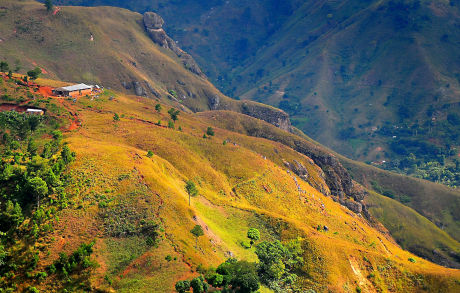Travel to the most mountainous country in the Caribbean and find out more about Haiti’s fight for independence. Then scroll down for some of our printable resources to recall what you have learnt!

Haiti's mountainous landscape
A Little Geography ...
- Haiti is found on the island of Hispaniola in the Caribbean. It covers the western third of the island. The other two-thirds is the Dominican Republic.
- The third-largest country in the Caribbean (after Cuba and the Dominican Republic), it covers more than 27,000 square kilometres, and has a population of about 10 million people. The capital is Port-au-Prince.
- The native American name for the country – Hayti – means ‘land of the mountains’. Haiti’s highest peak is Pic la Selle reaching 2,680 metres (8,793 ft) above sea level. The country’s rugged mountains, tropical forests and beautiful beaches rival those of other Caribbean nations.
- Agriculture used to be the country’s main source of income. Coffee, cocoa and mangoes are still important exports, but soil erosion (caused by deforestation and overgrazing) and a series of natural disasters have led to a decline in the agricultural sector. Industry, manufacturing and tourism also contribute to the economy.
A Little History ...
- In 1492, Christopher Columbus landed on the island of Hispaniola, his first destination in the Americas. It fell to Spanish rule, but in 1697, Spain accepted France’s claim to the western third of the island. Today, the main languages in Haiti are Creole and French.
- The French brought thousands of slaves from Africa to Haiti, to work on coffee, cotton and sugar cane plantations. By the end of the 18th century, there were more African slaves than French in the country. Nearly half a million slaves rebelled in the Haitian Revolution (1791–1804). Their victory ended the country’s colonial rule and slavery, creating the world’s first black republic, as well as the first independent Caribbean state. Haiti may have gained freedom, but France later demanded compensation for its former slave owners. It was a bitter legacy – and Haiti did not clear its debt to France until 1947.
- In the century that followed independence, Haiti was ruled by over 70 different dictators. In 1991, Jean-Bertrand Aristide became the country’s first democratically elected president, but he was overthrown by the military less than a year later. The country has been more stable in recent times, with a president now elected every five years.
- In 2010, Haiti was hit by a devastating earthquake. More than 200,000 people were killed and more than 2 million were left homeless. Haiti is still trying to rebuild its economy and infrastructure. A cholera epidemic in late-2010 added to the nation’s misery, and has now claimed more than 9,000 lives.

Haiti earthquake and relief efforts
And Some Interesting Facts …
- Haiti’s currency, the gourde, is named after the gourd plant. This dates back to 1807 when President Henri Christophe made gourds the base of the national currency and claimed all gourds as the property of the state!
- The country’s capital Port-au-Prince was founded in 1749. It was named after Le Prince, a French ship anchored in the bay.
- Voodoo is an important religion in Haiti. People pray to gods and spirits to help them. There are often voodoo rituals with music, dancing and drumbeats.
About the Haiti Flag

The flag has two bands of colour, blue and red. In the centre there is a crest on a white background, bearing the country's motto "L'Union Fait La Force", which translates as"Union Makes Strength".
Our Haiti Resources
In a choice of blank or lined our Haiti booklets make a fun and different way to present project work. Folding instructions can be found here.
Whether you prefer to colour them yourself or print our red and blue versions, celebrate Haiti with our Haiti bookmarks.
Children can work on finding some interesting facts out about Haiti with the help of this simple worksheet, which includes some location work too.
Here's a colouring page of the Haiti flag to print for the kids. It's not an easy one to colour in!
This printable jigsaw will soon have children recognising their flags. This one features the flag of Haiti. Instructions and cutting guides are here.
If you need a Haiti flag, you've come to the right place! We have five different sizes for printing in the PDF file below.
There are two versions of this Haiti location worksheet. The first is guided - in that we provide the country and capital city names and just ask the children to find Haiti and Port au Prince. The second is blank and much harder.
Learn about the country of Haiti and present your work on our handy Haiti notebooking pages.
This simplified outline map shows children the position and scale of Haiti relative to its surroundings.
This is a very simple fact-finding worksheet on Haiti, with plenty of space for children to gather together any interesting information they have discovered.


